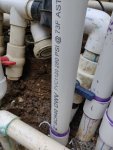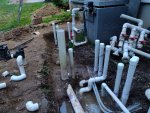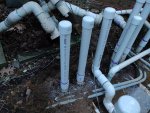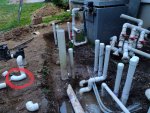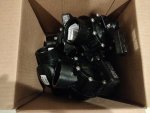I just started rebuilding my pool plumbing. It had to be done as I had to raise the grade of the area where the plumbing was sitting, to raise the grade of the land.
As you can see in the pictures, I've already cut a hole in the ground so I could access all my pool lines. I cut all of them, added a coupling to each and attached a new pipe going straight up in the air with a cap. We're now ready to remove the filter (that we already emptied), heater and all, raise the grade, then cut all lines to the needed height, add new valves, etc.
However, I just noticed what could be my first big mistake. The PVC I've been using is Sch 40 DWV 280PSI. I've been reading around this site and others, that one should not use Sch 40 DWV, as it's not made for the high pressure of pool plumbing. However, this PVC is supposed to be for 280PSI, which is higher than the PSI of the non-DWB pipe that's being recommended.
I'm hoping someone can make my day and tell me that there's no downside to leaving the work I've already done. If not, it's back to the mud pit!
Thanks for your help on this...
As you can see in the pictures, I've already cut a hole in the ground so I could access all my pool lines. I cut all of them, added a coupling to each and attached a new pipe going straight up in the air with a cap. We're now ready to remove the filter (that we already emptied), heater and all, raise the grade, then cut all lines to the needed height, add new valves, etc.
However, I just noticed what could be my first big mistake. The PVC I've been using is Sch 40 DWV 280PSI. I've been reading around this site and others, that one should not use Sch 40 DWV, as it's not made for the high pressure of pool plumbing. However, this PVC is supposed to be for 280PSI, which is higher than the PSI of the non-DWB pipe that's being recommended.
I'm hoping someone can make my day and tell me that there's no downside to leaving the work I've already done. If not, it's back to the mud pit!
Thanks for your help on this...


